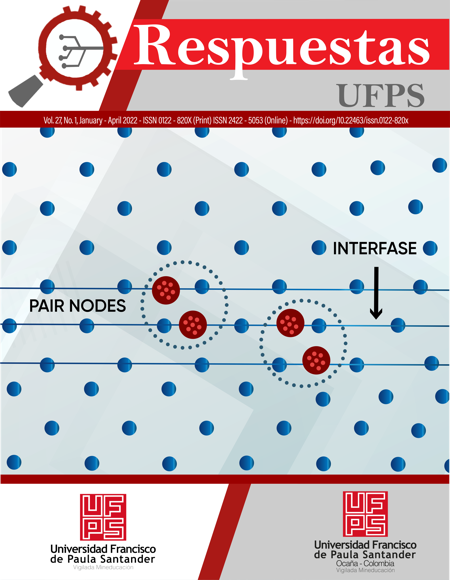Programación lineal binaria para la planificación de sistemas inalámbricos
A binary linear programming to the planning of wireless systems
Contenido principal del artículo
La localización de puntos de acceso para redes Wi-Fi en un escenario postpandemia propone una aplicación en la planificación y reestructuración de los sistemas inalámbricos existentes. Las estrategias educativas como el aula invertida, entre otras, exigen el desempeño integral del sistema. En este trabajo se propone una metodología utilizando programación lineal binaria como estrategia para lograr la planificación de un sistema Wi-Fi que pueda tener los objetivos de cobertura, capacidad de usuarios e interferencia de canales. Los resultados muestran una mejor cobertura, mayor velocidad por usuario y una cantidad optimizada de equipos por sector en los laboratorios de la Universidad del Magdalena.
Descargas
Datos de publicación
Perfil evaluadores/as N/D
Declaraciones de autoría
Indexado en
- Sociedad académica
- Universidad Francisco de Paula Santander
- Editorial
- Universidad Francisco de Paula Santander
Detalles del artículo
O. Holland, H. Bogucka, y A. Medeisis, «Coral Cognitive WiFi Networking System», en Opportunistic Spectrum Sharing and White Space Access: The Practical Reality, Wiley, 2015, pp. 123-140. doi: 10.1002/9781119057246.ch6.
A. Hernandez-Solana, D. Perez-Diaz-De-Cerio, M. Garcia-Lozano, A. V. Bardaji, y J. L. Valenzuela, «Bluetooth Mesh Analysis, Issues, and Challenges», IEEE Access, vol. 8, pp. 53784-53800, 2020, doi: 10.1109/ACCESS.2020.2980795.
J. Xiao y J. T. Li, «Design and implementation of intelligent temperature and humidity monitoring system based on ZigBee and WiFi», Procedia Computer Science, vol. 166, pp. 419-422, 2020, doi: 10.1016/j.procs.2020.02.072.
M. T. Islam y B.-Y. Choi, «Jointly Maximizing Throughput and Utilization for Dense Enterprise WLANs», en 2019 IEEE International Smart Cities Conference (ISC2), oct. 2019, pp. 753-759. doi: 10.1109/ISC246665.2019.9071712.
K. Poularakis, G. Iosifidis, y L. Tassiulas, «Joint Deployment and Pricing of Next-Generation WiFi Networks», IEEE Transactions on Communications, vol. 67, n.o 9, pp. 6193-6205, 2019, doi: 10.1109/TCOMM.2019.2919590.
P. Basu, C.-K. Chau, A. Iu. Bejan, R. Gibbens, S. Guha, y M. P. Johnson, «Efficient multicast in hybrid wireless networks», en MILCOM 2015 - 2015 IEEE Military Communications Conference, oct. 2015, pp. 306-311. doi: 10.1109/MILCOM.2015.7357460.
A. Sibille, «MIMO terminals performance evaluation in a local propagation context», en 2015 1st URSI Atlantic Radio Science Conference (URSI AT-RASC), may 2015, pp. 1-1. doi: 10.1109/URSI-AT-RASC.2015.7302983.
J. Mack, S. Gazor, A. Ghasemi, y J. Sydor, «Dynamic Channel Selection in cognitive radio WiFi networks: An experimental evaluation», en 2014 IEEE International Conference on Communications Workshops, ICC 2014, 2014, pp. 261-267. doi: 10.1109/ICCW.2014.6881206.
F. Chen, B. Huegel, y F. Dressler, «Realistic simulation and experimental validation of adjacent-channel interference in planning of industrial wireless networks», PE-WASUN’11 - Proceedings of the 8th ACM Symposium on Performance Evaluation of Wireless Ad Hoc, Sensor, and Ubiquitous Networks, pp. 97-103, 2011, doi: 10.1145/2069063.2069080.
M. Bernaschi, F. Cacace, A. Davoli, D. Guerri, M. Latini, y L. Vollero, «A CAPWAP-based solution for frequency planning in large scale networks of WiFi Hot-Spots», Computer Communications, vol. 34, n.o 11, pp. 1283-1293, 2011, doi: 10.1016/j.comcom.2011.01.002.
O. Sandoval, G. David Gonzalez, J. Hamalainen, y S. Yoo, «Indoor planning and optimization of LTE-U radio access over WiFi», IEEE International Symposium on Personal, Indoor and Mobile Radio Communications, PIMRC, 2016, doi: 10.1109/PIMRC.2016.7794858.
P. Kar y B. Dappuri, «Site Survey and Radio Frequency Planning for the Deployment of Next Generation WLAN», 2018 International Conference on Wireless Communications, Signal Processing and Networking, WiSPNET 2018, pp. 1-4, 2018, doi: 10.1109/WiSPNET.2018.8538731.
W. Sangkusolwong y A. Apavatjrut, «Indoor WIFI Signal Prediction Using Modelized Heatmap Generator Tool», ICSEC 2017 - 21st International Computer Science and Engineering Conference 2017, Proceeding, vol. 6, pp. 61-64, 2018, doi: 10.1109/ICSEC.2017.8443928.
L. Zheng, J. Chen, C. Joe-Wong, C. W. Tan, y M. Chiang, «An economic analysis of wireless network infrastructure sharing», 2017 15th International Symposium on Modeling and Optimization in Mobile, Ad Hoc, and Wireless Networks, WiOpt 2017, 2017, doi: 10.23919/WIOPT.2017.7959885.
Y. Jian, U. P. Moravapalle, C. F. Shih, y R. Sivakumar, «Duet: An adaptive algorithm for the coexistence of LTE-U and WiFi in Unlicensed spectrum», 2017 International Conference on Computing, Networking and Communications, ICNC 2017, pp. 19-25, 2017, doi: 10.1109/ICCNC.2017.7876095.
X. Wang, F. Lin, y Y. Wu, «A Novel Positioning System of Potential WiFi Hotspots for Software Defined WiFi Network Planning», 2019 16th IEEE Annual Consumer Communications and Networking Conference, CCNC 2019, 2019, doi: 10.1109/CCNC.2019.8651733.
A. Roy, P. Chaporkar, A. Karandikar, y P. Jha, «Optimal Radio Access Technology Selection in an SDN based LTE-WiFi Network», en 2019 International Symposium on Modeling and Optimization in Mobile, Ad Hoc, and Wireless Networks (WiOPT), jun. 2019, pp. 1-8. doi: 10.23919/WiOPT47501.2019.9144129.
S. M. Ali, «A novel optimization based algorithmic technique to improve QoS of high efficiency WLANs using M/D/1 model», AEU - International Journal of Electronics and Communications, vol. 110, p. 152866, 2019, doi: 10.1016/j.aeue.2019.152866.
M. Drissi y M. Oumsis, «Multi-criteria vertical handover comparison between Wimax and Wifi», Information (Switzerland), vol. 6, n.o 3, pp. 399-410, 2015, doi: 10.3390/info6030399.
B. K. Barman, S. N. Yadav, S. Kumar, y S. Gope, «IOT Based Smart Energy Meter for Efficient Energy Utilization in Smart Grid», en 2018 2nd International Conference on Power, Energy and Environment: Towards Smart Technology (ICEPE), jun. 2018, pp. 1-5. doi: 10.1109/EPETSG.2018.8658501.
B. H. Jung, N. O. Song, y D. K. Sung, «A network-assisted user-centric WiFi-offloading model for maximizing per-user throughput in a heterogeneous network», IEEE Transactions on Vehicular Technology, vol. 63, n.o 4, pp. 1940-1945, 2014, doi: 10.1109/TVT.2013.2286622.








